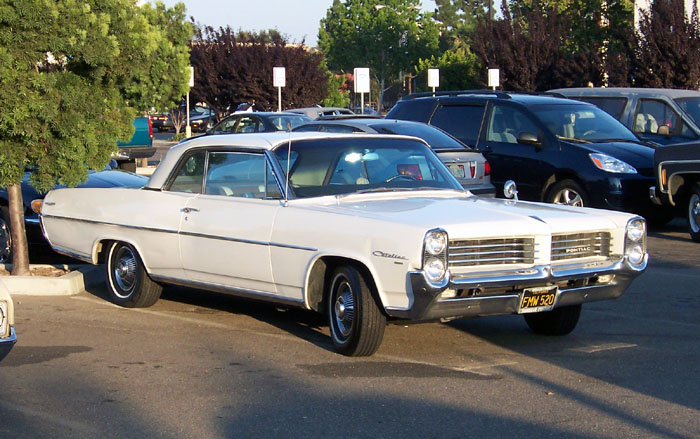I saw a television show recently about a car you just program and it’ll take you wherever you want to go.
You don’t even have to drive it; you just kick back and relax.
Eventually, the TV guy said, every car will be that way. Want to go to San Francisco? Just punch a few buttons and the car will do the rest.
The technology is such that vehicles will know where the others are at all times, so we won’t have to worry about accidents.
At first, I thought the idea was outrageous; but then realized it is entirely possible — and probable.
Who would have thought years ago that you could program a travel destination into a little black GPS box, plug it into the cigarette lighter and expect it to talk to you, directing you when to turn left and exit right?
All this high-tech stuff got me thinking about the cars of my youth and how simple they were — and often unreliable, I might add.
When you took a trip in those days, you always had to worry about your car breaking down or getting a flat tire. You often saw people changing tires by the side of the road.
I just read a book about the singer Joni Mitchell, who in the ’70s drove with friends to Damariscotta in a car that kept breaking down, so she bought a used Mercedes, and that kept breaking down, too.
It is unthinkable today that someone so famous would have car trouble, but that’s how it was back in the ’60s and ’70s.
I remember with fondness my first car, a big, white Pontiac Catalina with a light blue interior.
My sister, Laura, named it Moby Dick and called it the big white whale.
I bought the 1960s-something Pontiac for $75 from my friend, Susan, drove it for the summer and sold it in the fall for $200. That was no small chunk of change in those days, and I was quite pleased to think I had cleared such a profit.
I drove that car all over the place that summer, and it was wonderful except that when I ventured farther than five miles, it would overheat and I had to stop and put water in the radiator.
Back in the early ’70s, most of us carried gallon jugs of water in the trunk if we were smart. We didn’t want to have to knock on someone’s door asking for water, although I’m sure that happened more than once.
After I’d been in college a while, I bought a humongous two-door Thunderbird for $1,200 from a friend in Hartford, Conn. It was a beaut — gold, with a white top and white leather interior, as well as electric windows, seats and radio antenna.
It was so luxurious and comfortable, I could drive all the way from Hartford to Skowhegan without stopping. I remember with great clarity popping an eight-track tape into the deck on one trip and listening to Neil Diamond singing “September Morn.” I played that tape over and over, singing along with him at the top of my lungs.
The T-bird didn’t have many mechanical problems that I recall, but being in the city presented a different issue: My prized possession became the target of thieves.
They were clever, too, and managed to slip quietly into vehicles overnight and start them without having a key.
One dark morning I headed to the street where my car was parked, climbed in and attempted to put the key in the ignition to no avail. I tried two or three times.
Grabbing a flashlight, I discovered a large screw had been jammed into the ignition, ostensibly by a would-be thief trying to start the motor.
After that incident, I learned there was a bar you could clamp on your steering wheel at night to prevent thieves from stealing your car. But I much preferred another marvelous invention called a “kill switch,” which could be installed in your glove box, under the dash or in another obscure place. Turning the switch effectively killed the motor.
A mechanic put a kill switch in my glove compartment and whenever I parked the car, I’d reach in, flip the switch and then lock the glove box. No chance anyone could steal my car then because it wouldn’t start. I was tickled to think I had outwitted the vehicle snatchers.
When I ultimately moved back to Maine in the late ’80s, I had a little blue Toyota Corolla that ran like a charm, never broke down and used minimal gasoline.
I went all over rural Somerset County with that car, covering town meetings, accidents, fires and other stories, often driving over rough, potholed or muddy roads. Eventually, the car’s springs wore out and its body rusted away, nearly falling off the frame.
It was time to junk the car, even though the engine continued to purr like a kitten.
We don’t have such stories to tell about cars nowadays. Lots of people I know trade theirs in for newer, slicker ones, even after only a couple of years.
Times sure have changed from the days of Moby Dick, the gold T-Bird and Little Blue. Cars had character then. Now they’re just, well, cars.
Amy Calder has been a Morning Sentinel reporter 25 years. Her column appears here Mondays. She may be reached at acalder@centralmaine.com.
Copy the Story Link
Send questions/comments to the editors.





Success. Please wait for the page to reload. If the page does not reload within 5 seconds, please refresh the page.
Enter your email and password to access comments.
Hi, to comment on stories you must . This profile is in addition to your subscription and website login.
Already have a commenting profile? .
Invalid username/password.
Please check your email to confirm and complete your registration.
Only subscribers are eligible to post comments. Please subscribe or login first for digital access. Here’s why.
Use the form below to reset your password. When you've submitted your account email, we will send an email with a reset code.